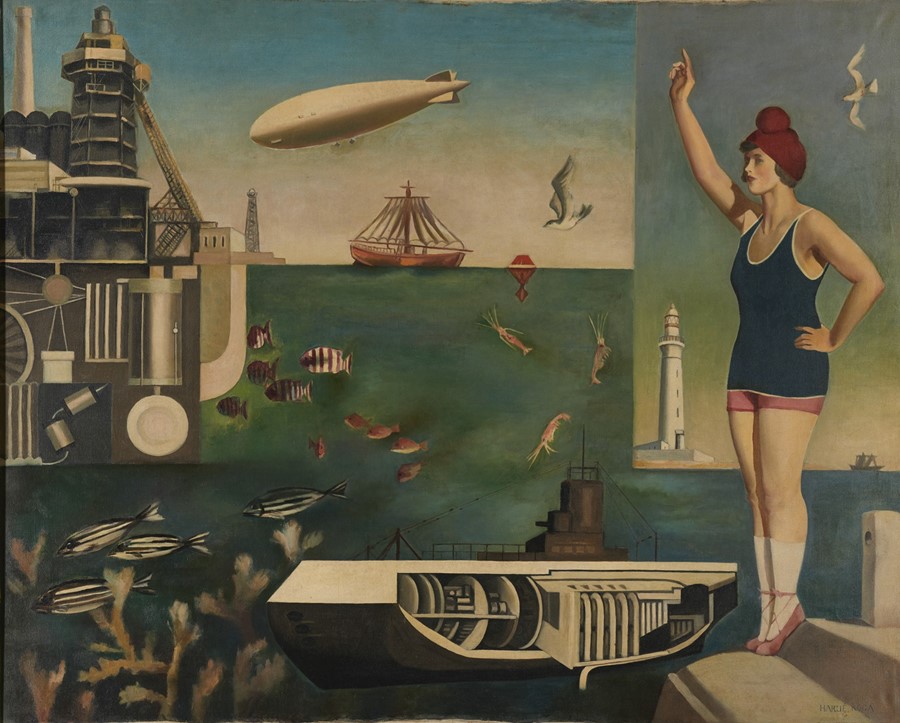Surrealism Beyond Borders, a new exhibition at Tate Modern, shines a light on the often-overlooked artists that embraced the movement across the globe
The official christening of the surrealist movement is well-documented. Though the term itself was coined by Apollinaire in 1917, it was another French poet and critic, André Breton, who would go on to lodge it in the public consciousness, in his 1924 Surrealist Manifesto. This was a movement that ran “completely against the tide”, he would later reflect. “In a violent reaction against the impoverishment and sterility of thought processes that resulted from centuries of rationalism, we turned toward the marvellous and advocated it unconditionally.”
Besides inspiring one of the pre-eminent cultural movements of the 20th century, Breton’s manifesto established Paris as the centre of its absurdist orbit. In the years that followed, the French capital’s gravitational pull would draw in everyone from Salvador Dalí and Man Ray, to Max Ernst and Leonora Carrington.
At the same time, however, the driving principles of surrealism’s Parisian pioneers – namely, a desire for “political, social, and personal liberation” in the wake of international upheaval – were flourishing elsewhere, from René Magritte’s native Belgium, to an artistic hub in the Serbian capital of Belgrade. Before long, this surrealist network had gone global, revolutionary ideas transmitted across continental borders via lobster telephone. An upcoming exhibition at Tate Modern, Surrealism Beyond Borders, seeks to showcase this global practice, placing surrealism’s best-known figures alongside those that have “fallen out of history”.
At the time, of course, the emergence of global surrealism didn’t go unnoticed by the artists and admirers whose names have come to dominate our understanding of the movement today. “The well-known figures were part of a community of artists, writers and thinkers,” says Matthew Gale, Tate Modern’s senior curator-at-large, and co-curator of Surrealism Beyond Borders, “and themselves valued those who have tended to fall out of history for a variety of reasons, often associated with the politics of gender and race.” Instead, perhaps, we can blame Eurocentric art institutions for burying the morbid dreamscapes of Argentina’s Antonio Berni, or the precise fantasias of the Japanese painter Koga Harue, just as they have overlooked the movement’s radical female artists.
“The appreciation of the work of Claude Cahun, Leonora Carrington, and Remedios Varo over recent decades has resulted from a rethinking of the gender blind spots in writing history,” Gale adds. “By looking more widely at the commitment of Inji Efflatoun or Amy Nimr, it shows how there were many more complex configurations at any given moment that deserve recapturing.”
Largely, the new show focuses on the “commonly held positions which unite these individuals”, placing their works side-by-side for an even-handed reimagining of the artistic movement. Photographs of the female body by Hans Bellmer stand in contrast to Ithell Colquhoun’s Scylla (1938), a mythical seascape that doubles as an image of the artist’s own body. Photos by Cahun are compared with those of Sri Lankan artist Lionel Wendt, whose work presents queer sexuality outside a western context.

Of course, the artists’ varied backgrounds also materialise in their works, making for a diverse retrospective, even if it is tied together by the same underlying principles. “Many of the featured artists found themselves in extreme conditions at one time or another,” Gale continues. “The second world war was a moment of crisis for surrealists – in common with millions of others – because their views were understood to be dangerously subversive. For those not arrested or killed by the authorities, there were choices of submission (the Tokyo surrealists sent to fight in Manchuria), clandestine activity (the Utrecht artists meeting secretly) or exile (those fleeing Europe to the Americas).”
“But their material conditions were often affected by less violent yet equally challenging situations – whether the conditions of repressive colonialism experienced in the Caribbean, Independence struggles of the 1950s, the anxieties of the Cold War, or China’s Cultural Revolution that expunged most traces of surrealist activity in 1930s Shanghai.”
While the movement’s most famous works are often humorous or playfully inventive, the curator suggests, surrealism also provided “networks of cooperation and support” that helped its adherents to find kinship, and to respond to their cultural or political circumstances through new, radical ways of thinking – from writers associated with the Négritude movement, who recognised the support offered by Paris surrealists, to those in 1950s Aleppo, who “found in surrealism a means to reimagine the post-Independence culture of Syria”. The point isn’t to overlook the melting clocks or the floating bowler hats, but to understand how they fit into this larger surrealist narrative, which goes far beyond the movement’s European roots.
Surrealism Beyond Borders is at Tate Modern from February 24 to August 29, 2022.






